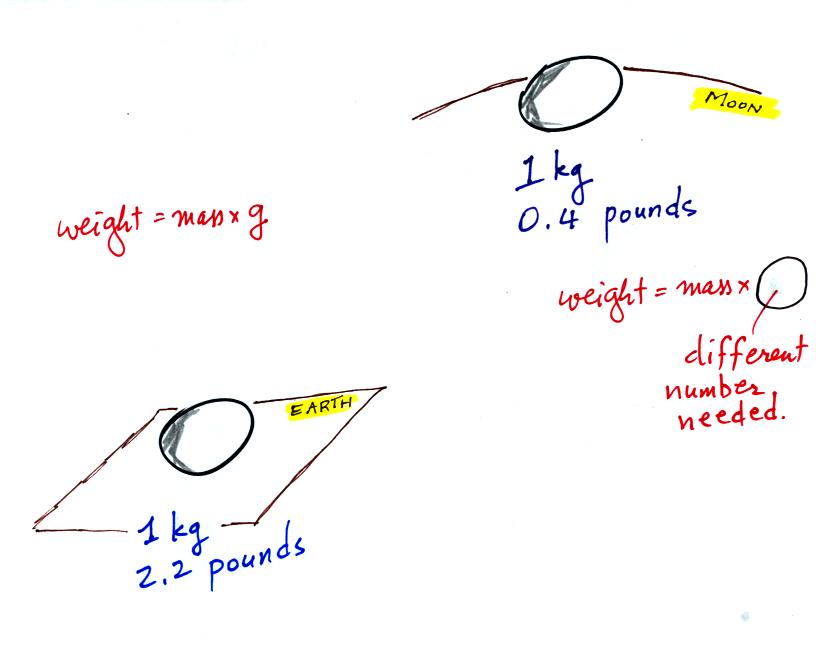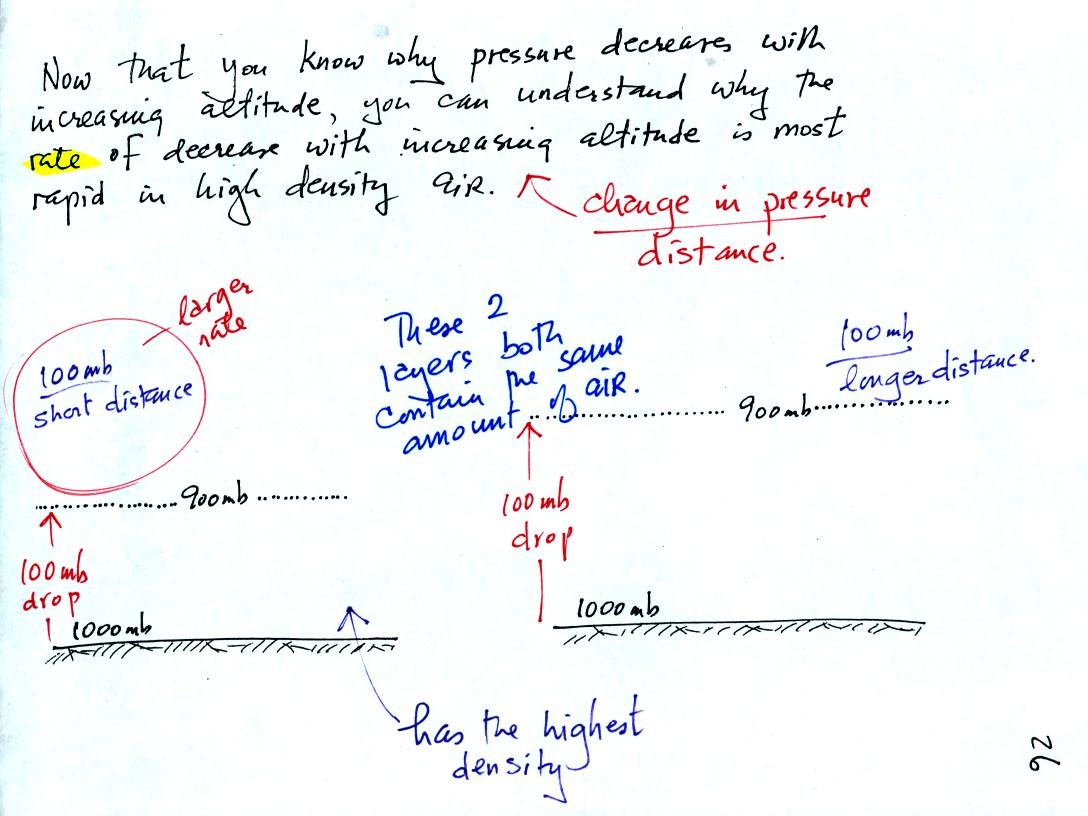Friday Sept. 8, 2006
A steel bar was passed around class. You were supposed to guess
how much it weighed.

This will be related to something covered during the class.
This semester's first optional
assignment was handed out. It will be
due next Friday (Sept. 15). You can earn a little bit
of extra credit on optional assignments (by the end of the semester the
extra credit can have an appreciable effect on your grade).
Optional assignments
should be ready to be turned in when you come to class. Don't let
the instructor see you finishing an optional assignment or working with
a friend in the last few minutes before the start of class (he is
likely to take your unfinished assignment and that of your friend).
The practice quizzes have been graded. Answers
to the questions are online. The average grade (59%) was quite a
bit lower than average grades in past NATS 101 courses. The
instructor made two suggestions: (1) that you get your notes organized,
keep everything (hand written notes and photocopied class notes)
together in one place and (2) that you briefly look over your notes
after each class (if they don't make sense then they won't make any
more sense in a week or two when it comes time to study for the next
quiz). If there is a part of one class that you don't understand
ask questions now, don't wait until just a day or two before the next
quiz.
The 1S1P Assignment #1 reports are due next Monday.
The bottles of mercury and water were passed around class (these were
discussed in class last Friday). Thanks
for being careful with the mercury.
The bottle of mercury is much heavier than the bottle of water.
The weight difference is telling us there is a big difference in
mass. On the earth we tend to use mass and weight
interchangeably. If you know the mass of an object you can
determine its weight by multiplying by g, the acceleration of
gravity. The value of g is constant on the surface of the earth.


If you were to carry an object from the
earth to the moon,
its mass would stay the same but its weight would change. The
value of g that you would need to use on the moon is different from the
one used on earth.


1. The
course instructor weighs around 160 pounds (actually a little less at
the end of the summer bicycling season). Pounds are units of
weight in the English units system. The instructor has a mass of
73 kilograms (kilograms are metric system units for mass).
2. To determine the instructor's weight you would need to
multiply his mass by g. The value of g is given in metric (9.8
m/sec2) and English (32 ft/sec2) units.
3a. The instructor has a weight of 715 Newtons (Newtons are
metric units of
force or
weight).
3b. To determine the instructor's mass in English units you would
need to
divide the weight by g.
You obtain 5 slugs (believe it or not, slugs are English units of mass).
4. On the moon the instructor would have the same mass (73
kg or 5 slugs).
5. The gravitational acceleration on the moon, 5.2 ft/sec2,
is about 1/6 of
what it is on the earth.
6. On the moon the instructor would weigh only 26 pounds.
The sketch on the right edge of the page above gives you
an idea of
what g,
the gravitational acceleration, really represents. You drop an
object. Gravity pulls downward on the object and causes it to
start to fall. Because gravity continues to exert a force on the
object, the object will fall faster and faster.
After 1 second it will have fallen 16 feet and will be
falling at a speed of 32 ft/sec. At the end of 2 seconds it will
be falling 64 ft/sec, after 3 seconds at 96 ft/sec. The speed of
the falling object is increasing by 32 feet/sec per second. Rate
of change of speed is acceleration. If gravity were the only
force acting on the falling object (and it usually is not) it wouldn't
matter how big or how heavy the object was, it's speed would increase
32 ft/sec per second. A small light weight object (like a ping
pong ball) and a larger
heavier object (like a bowling ball) would both fall at the same speed
and reach the ground
at the same time.

This ended up being a very busy figure. Basically the air that
surrounds the earth has mass. Gravity pulls downward on the
atmosphere giving it weight. Galileo proved that air has weight using the following
demonstration.
Pressure is defined as force divided by area; in this case the weight
of the atmosphere divided by area. Atmospheric pressure is
determined by and tells you something about the weight of the air
overhead.
Under normal conditions a 1 inch by 1 inch column of air stretching
from sea level to the top of the atmosphere will weigh 14.7 pounds (the
same as the steel bar passed around in class). Normal atmospheric
pressure at sea level
is 14.7 pounds per square inch (psi, the units you use when you fill up
your car or bike tires with air).
We will mostly use millibar (mb) units in our course.
Standard
atmospheric
pressure is about 1000 mb or 30 inches of mercury. The second
value refers to the reading from a mercury barometer. 1000
millibars is also equal to 1 bar or 1 atmosphere.

As you move upward through the atmosphere there is less and
less air
left overhead. The pressure at any level in the atmosphere is
determined by the weight of the air remaining overhead. Thus pressure
decreases with increasing altitude. Pressure changes much more
quickly when you move in a vertical direction than it does when you
move horizontally. This will be important when we cover surface
weather maps. Meterologists attempt to map out small horizontal
changes or differences in pressure on weather maps. These small
changes are what cause the wind to blow and produce weather.
Here is the hidden
optional assignment that I mentioned that I might include in
today's online class notes.
Pressure increases rapidly as you descend into the ocean. The
pressure at some level in the ocean is determined by the atmospheric
pressure plus the pressure produced by the weight of the water above
you. Water is much denser than air; The submarine in the lower
left hand corner of the figure above would experience a pressure of
2000
mb at 30 feet in the ocean, twice what it would feel at the surface of
the ocean.

As you move upward from the ground pressure decreases by 100
mb in both
layers in the figure above. Both layers contain the same amount
of air (if you refer
back to the previous figure you will find the a 100 mb drop when you go
from sea level to Tucson - 10% of the
air in the atmosphere lies between sea level and 3000 ft altitude in
Tucson). That air is found in a smaller volume in
the figure at left (the layer is thinner). This means the air at
left is denser than the air at right. The drop in air pressure in
the layer at left occurs in a shorter vertical distance than in the air
layer at right. That is a more rapid rate of pressure decrease
with distance than in the layer at right.
The rate of pressure decrease
with altitude is higher in the dense air at left than in the lower
density air at right.
This is a fairly subtle but important concept. We will use it
when we try to understand the intensification of hurricanes later in
the semester.
During the last 5 minutes of class we watched another short segment
from the video featuring Auguste Piccard. In this portion of the
program Auguste and Jacques descended to 10,000 feet depth in the ocean
in a bathyscaph. This was a test of the bathyscaph. In a
later descent Jacques and another person would go to 35,800 feet, the
deepest point in the ocean.







